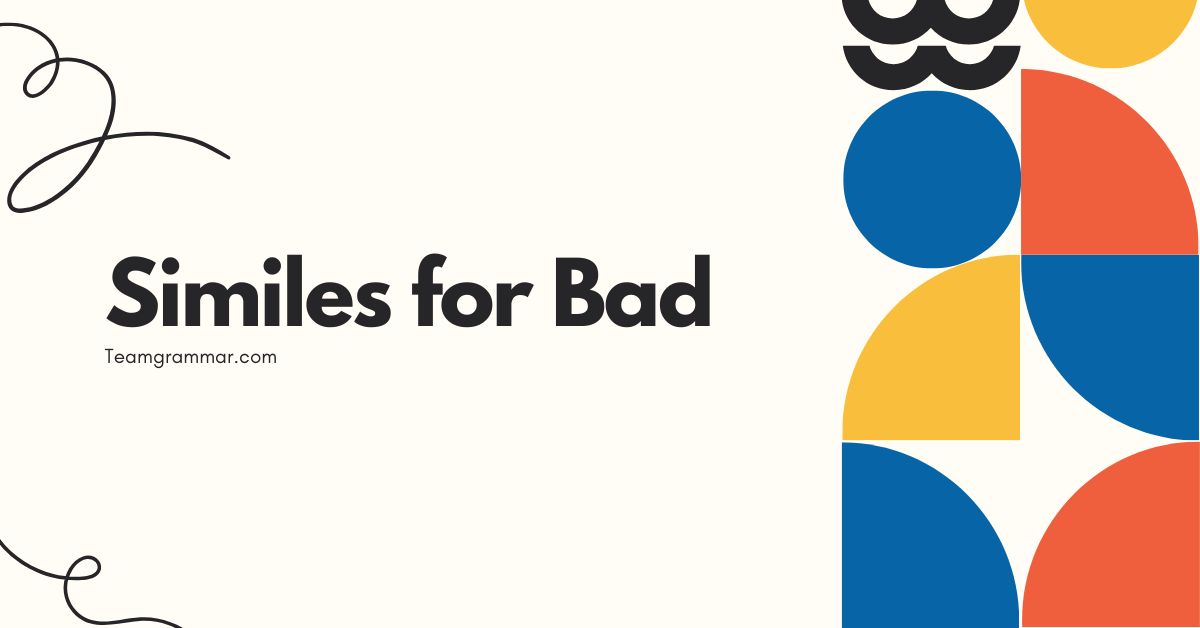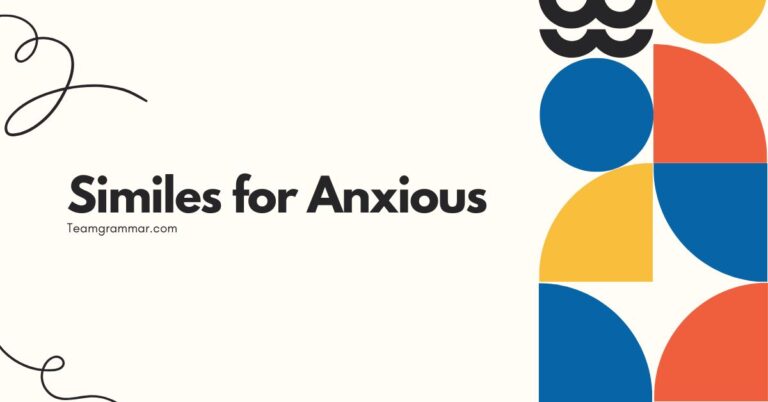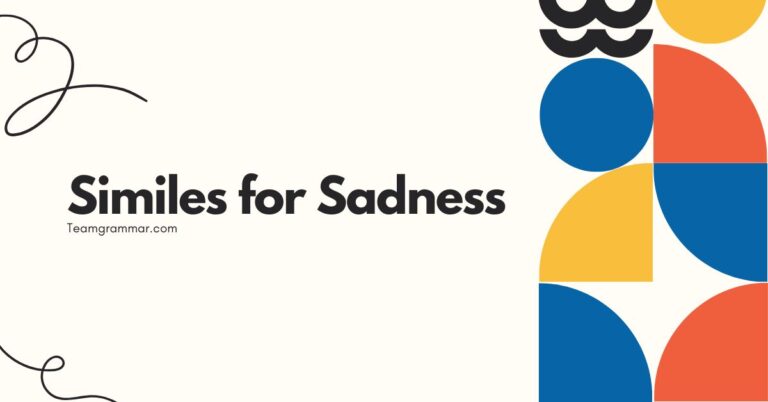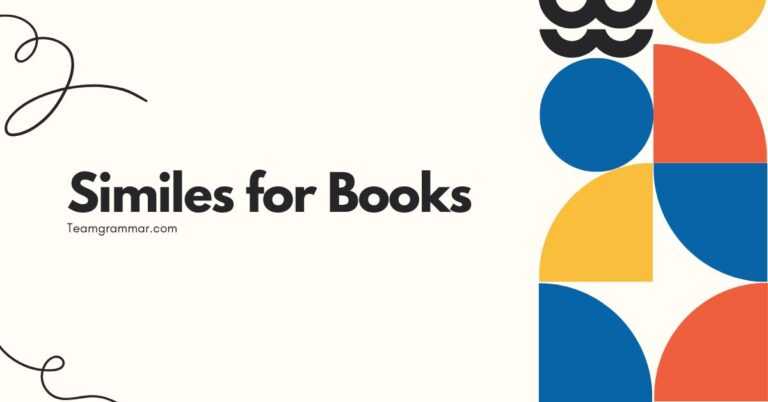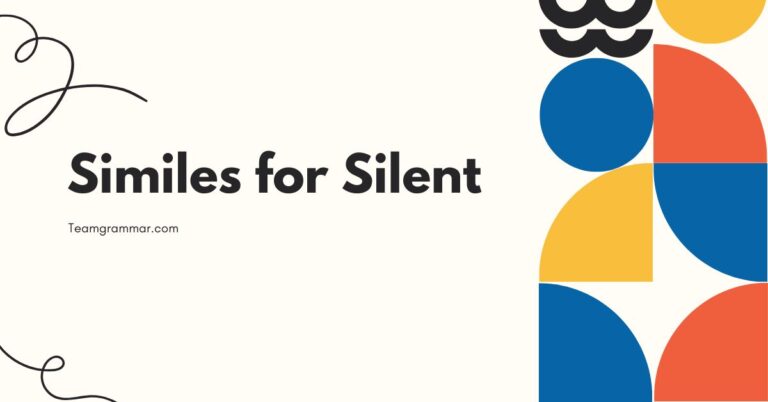49 Similes for Bad: Mastering Figurative Language
Similes are powerful tools in the English language, allowing us to create vivid comparisons and enhance our descriptions. Understanding how to use similes effectively, especially when describing negative qualities, is essential for both writing and speaking.
This article provides a comprehensive guide to using similes to express “bad,” covering definitions, structures, examples, usage rules, common mistakes, and practice exercises. Whether you’re a student, writer, or language enthusiast, this guide will help you master the art of using similes to convey negativity with precision and creativity.
Table of Contents
- Introduction
- Definition of Simile
- Structural Breakdown of Similes
- Types of Similes for “Bad”
- Examples of Similes for “Bad”
- Usage Rules for Similes
- Common Mistakes with Similes
- Practice Exercises
- Advanced Topics in Similes
- FAQ
- Conclusion
Definition of Simile
Asimileis a figure of speech that compares two unlike things using “like” or “as.” The purpose of a simile is to create a vivid image or deeper understanding by drawing a parallel between the two things being compared. It enhances descriptive language, making it more engaging and memorable for the reader or listener.
Similes are essential for effective communication, allowing for more nuanced and impactful expression.
Similes are classified as a type of figurative language, specifically a type of trope. Their primary function is to add color and depth to writing and speech.
They help to convey complex ideas or emotions by relating them to something familiar. The context in which a simile is used is crucial, as it determines the effectiveness and appropriateness of the comparison.
Structural Breakdown of Similes
The basic structure of a simile consists of three main components: the subject being described, the word “like” or “as,” and the object to which the subject is being compared. Understanding this structure is fundamental to creating effective similes.
The subject and object must be distinct entities, and the comparison should highlight a shared characteristic or quality.
The formula for a simile is:Subject + “like” or “as” + Object of Comparison. For example, “His anger was like a raging fire.” Here, “his anger” is the subject, “like” is the comparative word, and “a raging fire” is the object of comparison.
This structure helps to draw a clear parallel between anger and fire, emphasizing the intensity and destructiveness of his emotion.
Types of Similes for “Bad”
Similes for “bad” can be categorized based on the specific aspect of negativity they describe. We can classify them by appearance, behavior, taste, smell, and quality.
Each category requires a different approach to crafting the simile, focusing on the specific sensory details or characteristics that evoke a sense of negativity.
Similes for Bad Appearance
These similes describe something that looks unpleasant or unattractive. They often use comparisons to things that are dirty, decayed, or generally unappealing.
The goal is to create a visual image that conveys the negative aesthetic quality of the subject. The comparison should be immediately recognizable and evoke a clear sense of distaste.
Similes for Bad Behavior
These similes describe actions or conduct that are inappropriate, immoral, or offensive. They often compare the behavior to that of animals known for their unpleasant habits, or to destructive forces.
The comparison aims to highlight the reprehensible nature of the behavior, making it clear why it is considered “bad.” Strong verbs and evocative nouns are crucial for effective similes in this category.
Similes for Bad Taste
These similes describe flavors that are unpleasant or disgusting. They often compare the taste to things that are rotten, sour, or metallic.
The comparison should immediately convey the unpleasant sensation of the taste, making the reader or listener recoil. Sensory language is key in creating these similes.
Similes for Bad Smell
These similes describe odors that are offensive or nauseating. They often compare the smell to things that are decaying, putrid, or otherwise foul.
The comparison should evoke a strong negative reaction, clearly communicating the unpleasantness of the smell. These similes rely heavily on olfactory imagery.
Similes for Bad Quality
These similes describe things that are poorly made, ineffective, or unreliable. They often compare the quality to things that are broken, flimsy, or useless.
The comparison should highlight the inadequacy or deficiency of the subject, making it clear why it is considered “bad.” The similes often focus on the lack of functionality or durability.
Examples of Similes for “Bad”
Here are various examples of similes for “bad,” categorized by appearance, behavior, taste, smell, and quality. Each example is designed to illustrate how to effectively use similes to convey negativity in different contexts.
The examples are presented in tables for easy reference and comparison.
Appearance Examples
The following table provides examples of similes that describe something with a bad or unpleasant appearance. These aim to evoke a sense of distaste or unattractiveness through vivid comparisons.
| Simile | Explanation |
|---|---|
| As ugly as sin | Implies an extreme level of ugliness, associating it with something morally reprehensible. |
| Like a chewed-up piece of gum | Suggests something is worn out, unattractive, and undesirable. |
| As appealing as a mud puddle | Highlights the lack of attractiveness by comparing it to something dirty and uninviting. |
| Like a scarecrow after a storm | Conveys a disheveled and dilapidated appearance. |
| As drab as dishwater | Suggests a dull, uninteresting, and lifeless appearance. |
| Like something the cat dragged in | Implies a dirty, messy, and undesirable appearance. |
| As pale as a ghost | Describes an unnaturally pale or sickly appearance. |
| Like a broken doll | Suggests a damaged and unappealing appearance. |
| As rough as sandpaper | Describes a coarse and unpleasant texture or appearance. |
| Like a haunted house | Suggests a dilapidated and eerie appearance. |
| As colorless as a cloudy day | Implies a lack of vibrancy and appeal. |
| Like an old, cracked mirror | Suggests something is damaged, flawed, and unattractive. |
| As withered as an autumn leaf | Describes something that is shriveled, faded, and past its prime. |
| Like a deflated balloon | Conveys a sense of emptiness and lack of appeal. |
| As murky as swamp water | Suggests a dirty, unclear, and uninviting appearance. |
| Like a wilted flower | Describes something that has lost its freshness and beauty. |
| As scarred as an old battlefield | Implies a damaged and unattractive appearance due to past events. |
| Like a rusty old nail | Suggests something is corroded, unattractive, and useless. |
| As crumpled as a discarded paper | Describes something that is messy, disorganized, and unappealing. |
| Like a faded tattoo | Suggests something that has lost its vibrancy and appeal over time. |
| As bleak as a winter landscape | Implies a barren, unattractive, and depressing appearance. |
| Like a tattered flag | Suggests something that is worn, damaged, and unappealing. |
| As moldy as old bread | Describes something that is decaying, unclean, and undesirable. |
| Like a cracked pavement | Conveys a sense of damage, imperfection, and unattractiveness. |
Behavior Examples
The following table provides examples of similes that describe bad behavior. These comparisons aim to highlight the inappropriateness or offensiveness of the actions being described.
| Simile | Explanation |
|---|---|
| As rude as a pig | Implies that someone’s behavior is boorish, ill-mannered, and offensive. |
| Like a bull in a china shop | Suggests someone is clumsy, reckless, and likely to cause damage. |
| As sneaky as a fox | Highlights someone’s cunning, deceitful, and untrustworthy behavior. |
| Like a snake in the grass | Conveys a sense of hidden danger and treachery. |
| As stubborn as a mule | Suggests someone is obstinate, unyielding, and resistant to change. |
| Like a roaring lion | Implies someone is aggressive, loud, and intimidating. |
| As quiet as a mouse | Describes someone who is timid, reserved, and unobtrusive (can be negative in some contexts). |
| Like a raging storm | Suggests someone is chaotic, destructive, and uncontrollable. |
| As destructive as termites | Highlights someone’s ability to cause slow, insidious damage. |
| Like a parasite | Implies someone is dependent, exploitative, and harmful to others. |
| As annoying as a mosquito | Describes someone who is irritating, bothersome, and persistent. |
| Like a spoiled brat | Suggests someone is demanding, entitled, and ill-behaved. |
| As menacing as a shark | Conveys a sense of threat, danger, and aggression. |
| Like a vulture circling its prey | Implies someone is opportunistic, predatory, and eager to exploit others. |
| As aggressive as a hornet | Describes someone who is easily provoked, hostile, and combative. |
| Like a child throwing a tantrum | Suggests someone is immature, irrational, and disruptive. |
| As careless as a drunk driver | Highlights someone’s irresponsibility, negligence, and potential for harm. |
| Like a wolf in sheep’s clothing | Implies someone is deceptively dangerous and malicious. |
| As unpredictable as a hurricane | Describes someone who is erratic, unstable, and prone to sudden outbursts. |
| Like a broken record | Suggests someone is repetitive, boring, and tiresome. |
| As irritating as nails on a chalkboard | Describes behavior that is grating, unpleasant, and highly annoying. |
| Like a runaway train | Suggests someone is out of control, unstoppable, and headed for disaster. |
| As disloyal as Judas | Implies someone is treacherous, deceitful, and capable of betrayal. |
| Like a swarm of locusts | Conveys a sense of overwhelming destruction and devastation. |
Taste Examples
The following table provides examples of similes that describe bad taste. These comparisons aim to evoke a sense of disgust or unpleasantness related to flavor.
| Simile | Explanation |
|---|---|
| As bitter as gall | Implies an intensely unpleasant and acrid taste. |
| Like licking a rusty nail | Suggests a metallic, unpleasant, and potentially dangerous taste. |
| As sour as vinegar | Highlights an acidic, tart, and unpalatable taste. |
| Like eating dirt | Conveys a gritty, earthy, and distasteful flavor. |
| As bland as cardboard | Suggests a flavorless, uninteresting, and unsatisfying taste. |
| Like drinking swamp water | Implies a muddy, dirty, and unpleasant taste. |
| As rotten as spoiled milk | Describes a decaying, sour, and offensive taste. |
| Like chewing on rubber | Suggests a tough, tasteless, and unappetizing texture and flavor. |
| As metallic as blood | Highlights a coppery, unpleasant, and sometimes alarming taste. |
| Like eating ashes | Implies a dry, smoky, and unpleasant taste. |
| As pungent as old cheese | Describes a strong, sharp, and sometimes offensive taste. |
| Like swallowing sand | Suggests a gritty, dry, and unpleasant texture and flavor. |
| As acrid as burnt coffee | Highlights a bitter, harsh, and unpleasant taste. |
| Like chewing on aluminum foil | Implies a metallic, unpleasant, and slightly painful sensation. |
| As putrid as decaying meat | Describes a repulsive, foul, and offensive taste. |
| Like drinking battery acid | Suggests an extremely corrosive, dangerous, and unpleasant taste. |
| As chalky as medicine tablets | Highlights a dry, powdery, and often unpleasant taste. |
| Like eating tree bark | Implies a rough, woody, and generally unappetizing flavor. |
| As rancid as old oil | Describes a stale, unpleasant, and offensive taste. |
| Like chewing on soap | Suggests a soapy, bitter, and unpleasant taste. |
| As artificial as fake sweetener | Highlights a chemical, unnatural, and often unpleasant taste. |
| Like drinking diluted bleach | Implies a chemical, harsh, and extremely dangerous taste. |
| As flavorless as distilled water | Describes a completely devoid of taste, often unsatisfying. |
| Like eating uncooked flour | Conveys a dry, pasty, and unpleasant texture and flavor. |
Smell Examples
The following table provides examples of similes that describe bad smell. These comparisons aim to evoke a sense of disgust or unpleasantness related to odors.
| Simile | Explanation |
|---|---|
| As pungent as Limburger cheese | Implies a strong, sharp, and often offensive odor. |
| Like a garbage dump in summer | Suggests a foul, decaying, and extremely unpleasant smell. |
| As rotten as a corpse | Highlights a putrid, offensive, and nauseating odor. |
| Like walking into a sewer | Conveys a foul, unsanitary, and repulsive smell. |
| As acrid as burning rubber | Suggests a sharp, irritating, and unpleasant smell. |
| Like a skunk’s spray | Implies a strong, offensive, and lingering odor. |
| As musty as an old basement | Describes a damp, moldy, and unpleasant smell. |
| Like a fish market on a hot day | Suggests a strong, fishy, and decaying smell. |
| As foul as stagnant water | Highlights a dirty, contaminated, and unpleasant smell. |
| Like opening a tomb | Implies a stale, earthy, and potentially decaying smell. |
| As putrid as a compost heap | Describes a decaying, offensive, and unpleasant smell. |
| Like a gas leak | Suggests a strong, chemical, and potentially dangerous smell. |
| As rancid as old cooking oil | Highlights a stale, unpleasant, and offensive smell. |
| Like a dirty diaper | Implies a foul, unpleasant, and offensive smell. |
| As sulfurous as a volcano | Describes a strong, pungent, and sulfuric smell. |
| Like a chemical spill | Suggests a harsh, irritating, and potentially dangerous smell. |
| As suffocating as tear gas | Highlights an overpowering, irritating, and unpleasant smell. |
| Like an overflowing latrine | Implies an extremely foul, unsanitary, and repulsive smell. |
| As stale as old cigarette smoke | Describes a lingering, unpleasant, and offensive smell. |
| Like a rotting carcass | Suggests an extremely foul, decaying, and offensive smell. |
| As moldy as damp clothes | Highlights a musty, unpleasant, and unhealthy smell. |
| Like a brewery after a spill | Implies a strong, yeasty, and potentially unpleasant smell. |
| As pungent as mothballs | Describes a strong, chemical, and often unpleasant smell. |
| Like a dead animal on the road | Suggests an extremely foul, decaying, and offensive smell. |
Quality Examples
The following table provides examples of similes that describe bad quality. These comparisons aim to highlight the ineffectiveness, unreliability, or poor construction of something.
| Simile | Explanation |
|---|---|
| As flimsy as tissue paper | Implies something is weak, easily damaged, and unreliable. |
| Like a house of cards | Suggests something is unstable, easily toppled, and poorly constructed. |
| As unreliable as a broken watch | Highlights something is untrustworthy, inaccurate, and prone to failure. |
| Like a leaky faucet | Conveys a sense of persistent, annoying, and wasteful inefficiency. |
| As dull as a butter knife | Suggests something is ineffective, blunt, and unable to perform its task. |
| Like a flat tire | Implies something is useless, deflated, and unable to function. |
| As fragile as glass | Describes something is easily broken, delicate, and vulnerable. |
| Like a poorly built bridge | Suggests something is structurally unsound, dangerous, and likely to collapse. |
| As inefficient as a screen door on a submarine | Highlights something is completely useless and inappropriate for its intended purpose. |
| Like a broken toy | Implies something is damaged, non-functional, and disappointing. |
| As weak as water | Describes something is lacking strength, power, and effectiveness. |
| Like a faulty parachute | Suggests something is unreliable, dangerous, and likely to fail when needed most. |
| As useless as a chocolate teapot | Highlights something is completely impractical and serves no useful purpose. |
| Like a ghost town | Implies something is deserted, inactive, and lacking vitality. |
| As temporary as a sandcastle | Describes something is transient, unstable, and not built to last. |
| Like a mirage in the desert | Suggests something is illusory, deceptive, and ultimately unattainable. |
| As brittle as dry bones | Highlights something is fragile, easily broken, and lacking resilience. |
| Like a rusted hinge | Implies something is stiff, difficult to use, and poorly maintained. |
| As outdated as a rotary phone | Describes something is obsolete, antiquated, and no longer relevant. |
| Like a broken promise | Suggests something is unreliable, untrustworthy, and disappointing. |
| As unstable as quicksand | Highlights something is unpredictable, dangerous, and likely to cause problems. |
| Like a counterfeit bill | Implies something is fake, fraudulent, and lacking real value. |
| As worn out as an old shoe | Describes something is used up, ineffective, and no longer useful. |
| Like a cracked foundation | Suggests something has fundamental flaws, weaknesses, and is likely to fail. |
Usage Rules for Similes
To effectively use similes, several rules should be followed. Firstly, the comparison must be clear and understandable.
The reader should easily grasp the connection between the subject and the object of comparison. Secondly, the simile should be appropriate for the context.
A simile that is too outlandish or insensitive can detract from the overall message. Finally, avoid clichés.
Overused similes lose their impact and can make writing seem unoriginal.
Key rules for using similes:
- Clarity: Ensure the comparison is easily understood.
- Relevance: The comparison should be relevant to the subject being described.
- Originality: Avoid overused similes.
- Context: The simile should be appropriate for the tone and audience.
- Consistency: Maintain a consistent tone and style throughout your writing.
Common Mistakes with Similes
One common mistake is confusing similes with metaphors. While both are figures of speech that make comparisons, similes use “like” or “as,” while metaphors directly state that one thing *is* another.
For example, “He is *like* a lion” (simile) versus “He *is* a lion” (metaphor). Another mistake is using illogical or unclear comparisons.
The connection between the subject and object should be easily discernible.
Examples of Common Mistakes:
| Incorrect | Correct | Explanation |
|---|---|---|
| He is a lion (Intended as simile) | He is like a lion. | This corrects a metaphor into a simile by using “like.” |
| The car was as bad as a house. | The car was as bad as a broken washing machine. | This clarifies the comparison by using a more logical object. |
| She was as angry as a flower. | She was as angry as a hornet. | This makes the comparison more relevant to the subject’s emotion. |
Practice Exercises
Test your understanding of similes with these exercises. Fill in the blanks to complete the similes, or rewrite the sentences using effective similes.
These exercises are designed to reinforce the concepts covered in this article and to help you develop your ability to create and use similes effectively.
Exercise 1: Complete the Simile
| Question | Answer |
|---|---|
| 1. The food tasted as bad as __________. | spoiled milk |
| 2. His behavior was like __________. | a bull in a china shop |
| 3. The smell was as pungent as __________. | Limburger cheese |
| 4. The quality was as flimsy as __________. | tissue paper |
| 5. Her mood was like __________. | a stormy sea |
| 6. The room was as dark as __________. | a coal mine |
| 7. The task was as difficult as __________. | rocket science |
| 8. His temper was as volatile as __________. | gunpowder |
| 9. The situation was as bleak as __________. | a winter wasteland |
| 10. The argument was like __________. | pulling teeth |
Exercise 2: Rewrite Using Similes
| Question | Answer |
|---|---|
| 1. The coffee was bitter. | The coffee was as bitter as gall. |
| 2. He was clumsy. | He was like a bull in a china shop. |
| 3. The air was foul. | The air was as foul as a sewer. |
| 4. The product was unreliable. | The product was as unreliable as a broken watch. |
| 5. She was angry. | She was as angry as a disturbed hornet. |
| 6. The night was dark. | The night was as dark as pitch. |
| 7. The challenge was daunting. | The challenge was like climbing Mount Everest. |
| 8. His reaction was explosive. | His reaction was like a volcano erupting. |
| 9. The news was depressing. | The news was as depressing as a funeral dirge. |
| 10. The negotiation was difficult. | The negotiation was like wading through mud. |
Advanced Topics in Similes
For advanced learners, exploring more nuanced aspects of similes can enhance their writing and communication skills. This includes understanding the use of implied similes, where the “like” or “as” is omitted, and the creation of extended similes, where the comparison is developed over several sentences or paragraphs.
Additionally, exploring the cultural and contextual variations in simile usage can provide a deeper appreciation for the art of figurative language.
Extended Similes: These similes develop a comparison over multiple sentences, creating a more detailed and impactful image.
Implied Similes: These similes suggest a comparison without explicitly using “like” or “as,” requiring the reader to infer the connection.
FAQ
Here are some frequently asked questions about similes to help clarify any lingering doubts.
- What is the difference between a simile and a metaphor?
A simile compares two things using “like” or “as,” while a metaphor directly equates one thing to another without using these words. A simile suggests a similarity, whereas a metaphor asserts an identity.
- Can a simile be a cliché?
Yes, if a simile is overused and lacks originality, it becomes a cliché. It’s best to avoid common similes and strive for fresh, creative comparisons.
- How do I create effective similes?
To create effective similes, focus on finding relevant and vivid comparisons that clearly highlight the shared characteristics between the subject and object. Avoid vague or illogical comparisons.
- Are similes only used in writing?
No, similes are used in both writing and speaking. They enhance communication by making descriptions more engaging and memorable.
- What are some examples of overused similes?
Some examples of overused similes include “as blind as a bat,” “as light as a feather,” and “as quiet as a mouse.”
- How can I avoid using clichés when writing similes?
To avoid clichés, brainstorm unique and unexpected comparisons. Think about specific details and try to find connections that are not immediately obvious.
- What is the purpose of using similes in writing?
The purpose of using similes is to make writing more vivid, engaging, and understandable. They help to convey complex ideas by relating them to something familiar.
- Can a simile be too complex?
Yes, a simile can be too complex if the comparison is obscure or difficult to understand. The goal is to clarify, not confuse, the reader.
- How do cultural differences affect the interpretation of similes?
Cultural differences can significantly impact the interpretation of similes, as the objects of comparison may have different meanings or connotations in different cultures. A simile that works well in one culture may not be effective or even understandable in another.
- What role do similes play in poetry?
Similes are crucial in poetry for creating imagery, evoking emotions, and enhancing the overall aesthetic appeal of the poem. They allow poets to convey complex ideas and feelings in a concise and impactful way.
Conclusion
Mastering the art of using similes, especially to convey negative qualities, is a valuable skill for anyone looking to improve their writing and communication. By understanding the structure, types, and usage rules of similes, you can create vivid and impactful descriptions that resonate with your audience.
Remember to avoid clichés and strive for originality in your comparisons. Practice using similes in your writing and speaking to develop your fluency and creativity.
With dedication and attention to detail, you can harness the power of similes to express yourself with greater precision and artistry.
The key takeaways from this article include the importance of clarity, relevance, and originality when crafting similes. By avoiding common mistakes and practicing regularly, you can develop your ability to create effective and engaging comparisons.
Keep exploring new and creative ways to use similes to enhance your writing and speaking skills. The more you practice, the better you will become at using similes to express yourself with clarity and impact.

